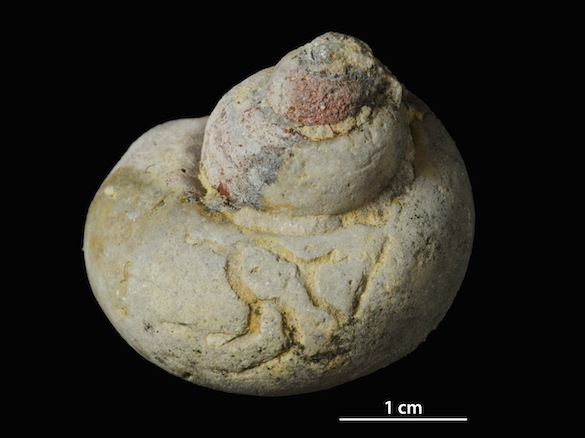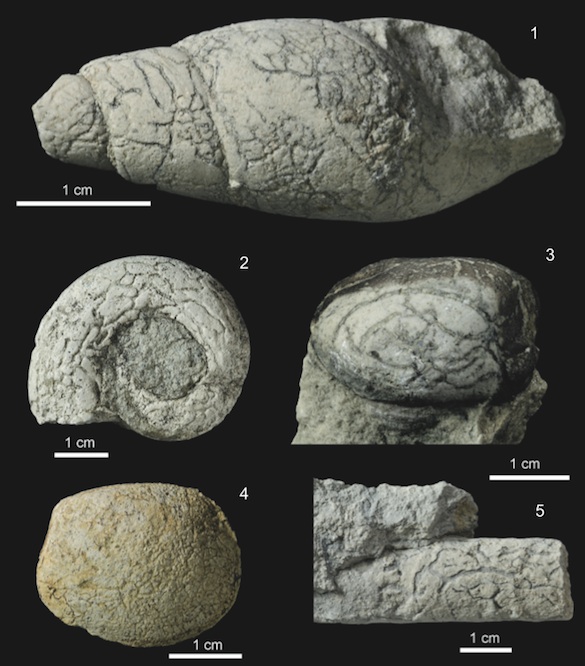 The fossils above have been in a previous post as examples of hyolith internal molds from the Middle Ordovician of northern Estonia. I collected them on my first visit to the Baltic countries in 2006. This week I want to recognize them again, but this time for the squiggly trace fossils you can just make out on their outer surfaces. These are the ichnospecies Arachnostega gastrochaenae Bertling, 1992. They are the subject of a paper that has just appeared in Palaeontologia Electronica entitled, simply enough, “The trace fossil Arachnostega in the Ordovician of Estonia (Baltica)“. The senior author is my Estonian buddy Olev Vinn. My Polish friend Michał Zatoń, my new Estonian colleague Ursula Toom, and I are co-authors.
The fossils above have been in a previous post as examples of hyolith internal molds from the Middle Ordovician of northern Estonia. I collected them on my first visit to the Baltic countries in 2006. This week I want to recognize them again, but this time for the squiggly trace fossils you can just make out on their outer surfaces. These are the ichnospecies Arachnostega gastrochaenae Bertling, 1992. They are the subject of a paper that has just appeared in Palaeontologia Electronica entitled, simply enough, “The trace fossil Arachnostega in the Ordovician of Estonia (Baltica)“. The senior author is my Estonian buddy Olev Vinn. My Polish friend Michał Zatoń, my new Estonian colleague Ursula Toom, and I are co-authors.
 Above is an unpublished image of a gastropod internal mold from the Estonian Ordovician taken by Olev. It shows very well the variable branching nature Arachnostega. This trace was formed by a deposit-feeding organism mining organic material in a sediment-filled shell. It worked along the sediment-shell interface, probably because there was more nutrient value at that margin. The internal mold was formed when sediment filling the shell was cemented and the shell dissolved away, leaving the hard mold behind.
Above is an unpublished image of a gastropod internal mold from the Estonian Ordovician taken by Olev. It shows very well the variable branching nature Arachnostega. This trace was formed by a deposit-feeding organism mining organic material in a sediment-filled shell. It worked along the sediment-shell interface, probably because there was more nutrient value at that margin. The internal mold was formed when sediment filling the shell was cemented and the shell dissolved away, leaving the hard mold behind.
 This is Figure 3.1 in the new paper. Note the variation in the traces as well as the shells it inhabited. The caption as published: Arachnostega gastrochaenae Bertling in a gastropod from Haljala Regional Stage (Sandbian), Aluvere Quarry, northern Estonia. GIT 399-948-1. 2. Arachnostega gastrochaenae Bertling in a gastropod from the Kunda Regional Stage (Darriwilian), Kunda Ojaküla, northern Estonia. GIT 404-355-1. 3. Arachnostega gastrochaenae Bertling in a bivalve from the Haljala Regional Stage (Sandbian), Aluvere Quarry, northern Estonia. GIT 399-1590-1. 4. Arachnostega gastrochaenae Bertling in a bivalve from the Haljala Regional Stage (Sandbian), Aluvere Quarry, northern Estonia. GIT 399-1601-1. 5. Arachnostega gastrochaenae Bertling in a cephalopod from the Uhaku Regional Stage (Darriwilian), Püssi, northern Estonia. GIT 695-12-1.
This is Figure 3.1 in the new paper. Note the variation in the traces as well as the shells it inhabited. The caption as published: Arachnostega gastrochaenae Bertling in a gastropod from Haljala Regional Stage (Sandbian), Aluvere Quarry, northern Estonia. GIT 399-948-1. 2. Arachnostega gastrochaenae Bertling in a gastropod from the Kunda Regional Stage (Darriwilian), Kunda Ojaküla, northern Estonia. GIT 404-355-1. 3. Arachnostega gastrochaenae Bertling in a bivalve from the Haljala Regional Stage (Sandbian), Aluvere Quarry, northern Estonia. GIT 399-1590-1. 4. Arachnostega gastrochaenae Bertling in a bivalve from the Haljala Regional Stage (Sandbian), Aluvere Quarry, northern Estonia. GIT 399-1601-1. 5. Arachnostega gastrochaenae Bertling in a cephalopod from the Uhaku Regional Stage (Darriwilian), Püssi, northern Estonia. GIT 695-12-1.
Our paper analyzes the distribution of Arachnostega through the Ordovician of Baltica, a paleocontinent with a long history, including a collision with Avalonia (western Europe today, more or less) in the Late Ordovician. By plotting the occurrences of Arachnostega over time, we conclude that the makers of Arachnostega likely preferred cool climates and bivalve shells over gastropods. The tracemakers may have also been negatively influenced by the many biotic changes associated with the Great Ordovician Biodiversification Event.
Please check out the article itself. As with all papers in Palaeontologia Electronica, it is open access.
References:
Bertling, M. 1992. Arachnostega n. ichnog. – burrowing traces in internal moulds of boring bivalves (late Jurassic, northern Germany). Paläontologische Zeitschrift 66: 177-185.
Vinn, O., Wilson, M.A., Zatoń, M. and Toom, U. 2014. The trace fossil Arachnostega in the Ordovician of Estonia (Baltica). Palaeontologia Electronica 17, Issue 3; 41A; 9 p.



Very cool!